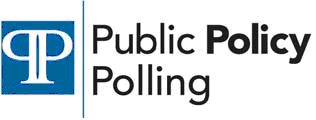Here are the enthusiasm gap numbers in every state where we've polled since switching over to likely voters a month ago:
| State | Projected 2010 Electorate | 2008 Result | Enthusiasm Gap |
| Texas | McCain +11 | McCain +11 | None |
| Maine | Obama +7 | Obama +18 | D -11 |
| Ohio | McCain +3 | Obama +4 | D -7 |
| Alaska | McCain +16 | McCain +21 | D +5 |
| North Carolina | McCain +9 | Obama +1 | D -10 |
| Louisiana | McCain +20 | McCain +19 | D -1 |
| Florida | McCain +3 | Obama +3 | D -6 |
| Illinois | Obama +9 | Obama +25 | D -16 |
| Pennsylvania | McCain +1 | Obama +10 | D -11 |
| Missouri | McCain + 7 | Tie | D -7 |
On average we're finding an electorate 6 points more Republican friendly than the results in the state in 2008. Combine that with the fact that Barack Obama has won over virtually no one while losing the support of roughly 10% of the people who voted for him and you have the equation for the oncoming Republican victory.
Let's go inside the enthusiasm numbers:
-The only states that haven't seen at least a 6 point Republican shift are Texas, Louisiana, and Alaska. Texas was discussed above. In Louisiana I think you do have a fair number of Republicans disgusted by David Vitter but not so disgusted they'll vote for a Democrat. Those folks may be staying home and blotting out an enthusiasm gap. In Alaska you don't have the opportunity this year to elect a Vice President from the state, which was a GOP turnout driver last time, and you also have Lisa Murkowski supporters who may be in the same boat as the Republicans who don't like Vitter- don't like Joe Miller, not going to come out for Scott McAdams either.
-The states where the Democratic dropoff is 10 points or more- Illinois, Pennsylvania, Maine, and North Carolina- all have incredibly unpopular Democratic Governors who aren't that strong even within their own parties. Obama's still pretty solid in those states at least within his own party, but a sense that their party's current leaders at the state level have not gotten the job done could be making Democrats less inclined to get out to the polls.
I'm going to be really interested to see our first California poll with the likely voter model since like Texas you have an unpopular Republican Governor there- although the GOP is lucky there in that he's retiring and Jerry Brown is proving to be no Bill White.

Your three smallest Republican shifts are in the states that McCain won by the most and your three largest are in the states Obama won by the most. Alaska, Texas, Tennessee, and Louisiana were the four states McCain did better than Bush. It's possible that the enthusiasm gap already existed in 2008 for these states.
ReplyDeleteObama's 2008 enthusiasm in Illinois was enormous. So a major drop when he's not running is expected. In the two others he had larger than expected increases.
This is not really an important issue. As long as they do they job honestly there’s nothing to say about them. I just hope that they really do they job right and make their countrymen proud about their doings.
ReplyDeleteI buy not these results just by the same reason. The enthusiasm gap affect only to the bluest states? The more liberal states are the more unhappy with Obama? I trust not this.
ReplyDeleteHow does this play out for Manchin in WV? He obviously has to carry a lot of Obama-disapprovers in order to win the race, but I don't think he lacks confidence that he can do that right now.
ReplyDeleteI know WV lost the reader poll last week, but if you guys need to poll somewhere new anytime soon, that would be a good place to head next.
I think there's one key point about the "enthusiasm gap" that's being lost:
ReplyDeleteWhen there is an enthusiasm gap, it's more accentuated in the POLLS, than it is in the POLLING BOOTH.
People become much less reluctant to answer polls when they are enthusiastic, but this gap, (where there is a difference in participation that correlates with whom you plan to vote for) is not as strong for voting, as it is for answering polls. It's also not as strong in total votes cast as it is in absentee cotes or early voting.
What really would help is to know the refusal rate of a poll and how that might have changed.
The most reliable polls might be ones that were mostly about other things and only threw in a few political questions at the end. A poll of likely voters taken from THAT sort of poll, might be more accurate.
Do you know what polls fit into this category? (where the political questions are an aside at the end)